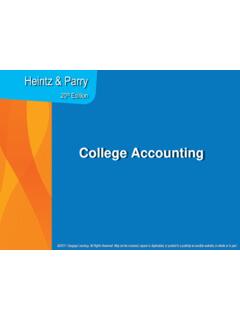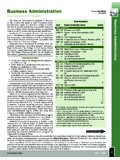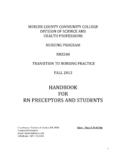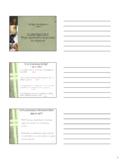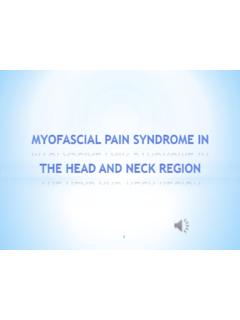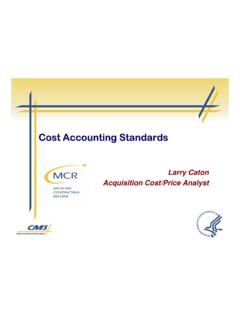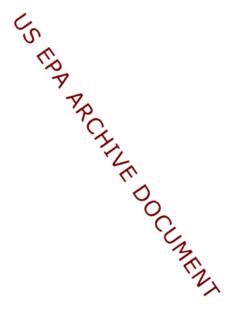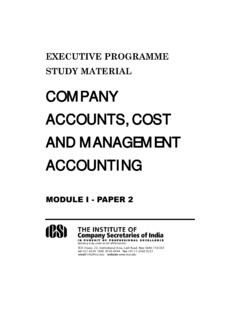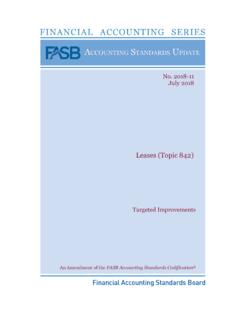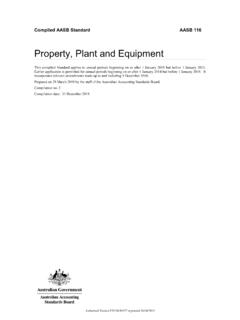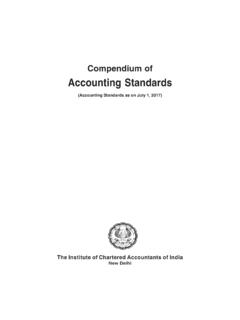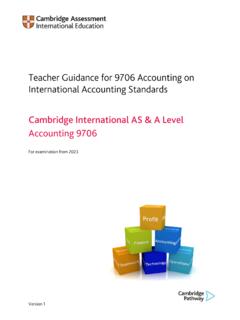Transcription of Accounting Principles 8th Edition - MCCC
1 Page 1-1 Page 1-2 Managerial AccountingManagerial AccountingFifth EditionWeygandt Kimmel KiesoPage 1-3study the distinguishing features of managerial the three broad functions of the three classes of manufacturing between product and period the difference between a merchandising and a manufacturing income how cost of goods manufactured is the difference between a merchandising and a manufacturing balance trends in managerial 1-4 Page 1-5 Managerial Accounting BasicsManagerial Accounting , also called management Accounting , is a field of Accounting that provides economic and financial information for managers and other internal Accounting applies to all types of businesses. Corporations Proprietorships Partnerships Not-for-profitPage 1-6 Managerial Accounting manufacturing and nonmanufacturing costs and how they are reported in the financial statements.
2 (Chapter 1) the cost of providing a service or manufacturing a product. (Chapters 2, 3, and 4) the behavior of costs and expenses as activity levels change and analyzing cost -volume-profit relationships within a company. (Chapters 5 and 6) Managerial Accounting ActivitiesPage and presenting data for management decision making. (Chapter 7) prices for external and internal transactions. (Chapter 8) management in profit planning and formalizing these plans in the form of budgets. (Chapter 9)Managerial Accounting BasicsManagerial Accounting ActivitiesPage a basis for controlling costs and expenses by comparing actual results with planned objectives and standard costs. (Chapters 10 and 11) and presenting data for capital expenditure decisions. (Chapter 12)Managerial Accounting BasicsManagerial Accounting ActivitiesPage 1-9SO 1 Explain the distinguishing features of managerial Managerial And Financial AccountingManagerial Accounting BasicsIllustration 1-1 Page 1-10 Managerial governed by generally accepted Accounting Principles .
3 B. Places emphasis on special-purpose information. c. Pertains to the entity as a whole and is highly aggregated. d. Is limited to cost QuestionManagerial Accounting BasicsSO 1 Explain the distinguishing features of managerial governed by generally accepted Accounting Principles . b. Places emphasis on special-purpose information. c. Pertains to the entity as a whole and is highly aggregated. d. Is limited to cost on notes pagePage 1-11SO 2 Identify the three broad functions of FunctionsManagerial Accounting BasicsPlanningMaximize short-term profit and market shareCommit to environmental protection and social programsAdd value to the businessDirectingControllingCoordinate diverse activities and human resourcesImplement planned objectivesProvide incentives to motivate employeesHire and train employeesProduce smooth-running operationKeeping activities on trackDetermine whether goals are metDecide changes needed to get back on trackMay use an informal or formal system of evaluationsPage 1-12SO 2 Identify the three broad functions of Accounting BasicsIllustration 1-2 Organization chartsshow the interrelationships of activities and the delegation of authority and responsibility within the StructurePage 1-13SO 2 Identify
4 The three broad functions of EthicsManagerial Accounting BasicsAll employees are expected to act ethically. Many organizations have codes of business financial frauds: Enron, Global Crossing, WorldComPage 1-14SO 2 Identify the three broad functions of EthicsManagerial Accounting BasicsCreating Proper IncentivesSystems and controls sometimes create incentives for managers to take unethical need to be effective and 1-15SO 2 Identify the three broad functions of EthicsManagerial Accounting BasicsCode of Ethical StandardsSarbanes-Oxley Act of 2002 (SOX) Clarifies management s responsibilities Requires certifications by CEO and CFO Selection criteria for Board of Directors and Audit Committee Substantially increased penalties for misconductPage 1-16 The management of an organization performs several broad functions. They , directing, and Directing, manufacturing, and controlling.
5 C. Planning, manufacturing, and Planning, directing, and controlling. Review QuestionManagerial Accounting , directing, and Directing, manufacturing, and controlling. c. Planning, manufacturing, and Planning, directing, and controlling. SO 2 Identify the three broad functions of on notes pagePage 1-17 Managerial Accounting BasicsIndicate whether the following statements are trueor accountants have a single role within an organization, collecting and reporting costs to Accounting reports are general-purpose and intended for external Accounting reports are special-purpose and issued as frequently as 2 Identify the three broad functions of on notes pagePage 1-18 Managerial Accounting BasicsIndicate whether the following statements are trueor activities and responsibilities can be classified into three broad functions: cost Accounting , budgeting, and internal a result of the Sarbanes-Oxley Act of 2002, managerial Accounting reports must now comply with generally accepted Accounting Principles (GAAP).
6 Managers must certify that a company maintains an adequate system of internal 2 Identify the three broad functions of on notes pagePage 1-19 Managerial cost ConceptsSO 3 Define the three classes of manufacturing should ask questions such as the costs are involved in making a product or providing a service? we decrease production volume, will costs decrease? impact will automation have on total costs? can we best control costs?Page 1-20 Managerial cost ConceptsSO 3 Define the three classes of manufacturing consists of activities and processes that convert raw materials into finished CostsIllustration 1-3 Page 1-21 Manufacturing CostsMaterialsRaw MaterialsBasic materials and parts used in manufacturing MaterialsRaw materials that can be physically and directly associated with the finished product during the manufacturing 3 Define the three classes of manufacturing 1-22 Manufacturing CostsIndirect MaterialsRaw materials that cannotbe easily associated with the finished physically part of the finished product orthey are an insignificant part of finished product in terms of part of manufacturing 3 Define the three classes of manufacturing 1-23 Direct LaborWork of factory employees that can be physically and directly
7 Associated with converting raw materials into finished LaborWork of factory employees that has no physical association with the finished product or for which it is impractical to trace costs to the goods CostsSO 3 Define the three classes of manufacturing 1-24 Costs that are indirectlyassociated with manufacturing the finished all manufacturing costs exceptdirect materials and direct called factory overhead, indirect manufacturing costs, or OverheadManufacturing CostsSO 3 Define the three classes of manufacturing 1-25 Which of the following is not an element of manufacturing overhead? manager s Plant manager s salary. c. Factory repairman s Product inspector s salary. Review QuestionSO 3 Define the three classes of manufacturing manager s Plant manager s salary. c. Factory repairman s Product inspector s salary. Solution on notes pagePage 1-26 Components:Costs that are an integral part of producing the in inventory an expense (COGS) until the goods are 4 Distinguish between product and period Versus Period CostsProduct Costs Direct materials Direct labor Manufacturing overheadPage 1-27 Charged to expense as all selling and administrative 4 Distinguish between product and period Versus Period CostsPeriod CostsPage 1-28 Product Versus Period CostsSO 4 Distinguish between product and period 1-4 Page 1-29 Product Versus Period CostsSO 4 Distinguish between product and period bicycle company has these costs: tires, salaries of employees who put tires on the wheels, factory building depreciation, wheel nuts, spokes, salary of factory manager, handlebars, and salaries of factory maintenance employees.
8 Classify each cost as direct materials, direct labor, or MaterialsTiresWheel nutsSpokesHandlebarsDirect LaborOverheadSalaries of employees who put tires on the depreciationFactory manager salaryFactory maintenance employees salaryPage 1-30 Manufacturing Costs in Financial StatementsUnder a periodic inventory system, the income statements of a merchandiser and a manufacturer differ in the cost of goods 5 Explain the difference between a merchandising and a manufacturing income Costs COGS Page 1-31 cost of Goods Sold Components (Periodic Inventory System)Manufacturing Costs in Financial StatementsSO 5 Explain the difference between a merchandising and a manufacturing income 1-5 Page 1-32 cost of goods sold sections of merchandising and manufacturing income statementsIllustration 1-6SO 5 Explain the difference between a merchandising and a manufacturing income Costs in Financial StatementsPage 1-33a.
9 $450, $500,000. c. $550, $600, the year, Red Company has cost of goods manufactured of $600,000, beginning finished goods inventory of $200,000, and ending finished goods inventory of $250,000. The cost of goods sold isReview QuestionSO 5 Explain the difference between a merchandising and a manufacturing income Costs in Financial StatementsBeg. Inventory$200,000+ COGs Manufactured600,000 Goods Available for Sale800,000-End. Inventory250,000 cost of Goods Sold$550,000a.$450, $500,000. c. $550, $600, on notes pagePage 1-34 Determining the cost of Goods ManufacturedTotal Work in Process (1) cost of beginning work in process and (2) total manufacturing costs for the current Manufacturing Costs sum of direct material costs, direct labor costs, and manufacturing overhead in the current 6 Indicate how cost of goods manufactured is Costs in Financial StatementsIllustration 1-7 Page 1-35 cost of Goods Manufactured ScheduleSO 6 Indicate how cost of goods manufactured is Costs in Financial StatementsIllustration 1-8 Page 1-36SO 6 Indicate how cost of goods manufactured is Costs in Financial StatementsPage 1-37SO 6 Indicate how cost of goods manufactured is Costs in Financial StatementsSolution on notes pagePage 1-38SO 7 Explain the difference between a merchandising and a manufacturing balance Costs in Financial StatementsIllustration 1-9 Inventory accounts for a manufacturerThe balance sheet for a merchandisingcompany shows just one categoryof SheetPage 1-39SO 7 Explain the difference between a merchandising and a manufacturing balance Costs in Financial
10 StatementsIllustration 1-10 Current assets sections of merchandising and manufacturing balance sheetsBalance SheetPage 1-40A cost of goods manufactured schedule shows beginning and ending inventories materials and work in process only b. Work in process onlyc. Raw materials onlyd. Raw materials, work in process, and finished goods Review QuestionSO 7 Explain the difference between a merchandising and a manufacturing balance Costs in Financial materials and work in process only b. Work in process onlyc. Raw materials onlyd. Raw materials, work in process, and finished goods Solution on notes pagePage 1-41 Manufacturing Costs in Financial StatementsIllustration:Suppose you started your own snowboard factory, KRC Boards. Here are some of the costs that your snowboard factory would incur. Assign the following costs:Solution on notes pageSO 7 Explain the difference between a merchandising and a manufacturing balance 1-11 Page 1-42 Manufacturing Costs in Financial StatementsIllustration 1-11 Solution on notes pagePage 1-43 Manufacturing Costs in Financial StatementsIf KRC Boards produces 10,000 snowboards the first year, what would be the total manufacturing costs?
